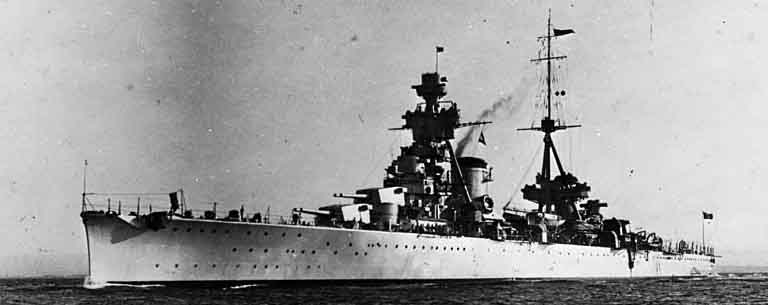
In 1920, Italy had few modern cruisers. The Washington Treaty set new standards to be followed by all naval forces, notably the heavy cruiser, with an arrangement of 8-in (203 mm) guns for 10,000 tons standard, framed itself in a global tonnage by nation. Italy had the same as France, 175,000, in which it was possible to start designing the next generation of cruisers. Aside the light Giussano class designed to catch up French large destroyers, Italy still had to design its first 8-in cruisers.
The Trento appeared in the 1924 program as ships for which speed was paramount. Tactically they had to escape battleships while posing a threat to all other types of vessels, preferably light cruisers as their protection was already barely sufficient against 6-in shells. Thus, this mirrored the “tin-clad” tendency already shown by the light cruisers of the Regia Marina. In total three of this new breed were started, Trento, Trieste, but one modified heavily and completed much later, Bolzano. They will be studied all there for practicality. Their wartime career was eventful, they participated in the battles of Calabria, Cape Spartivento, and Cape Matapan. Trieste was sunk, but Trieste and Bolzano survived.
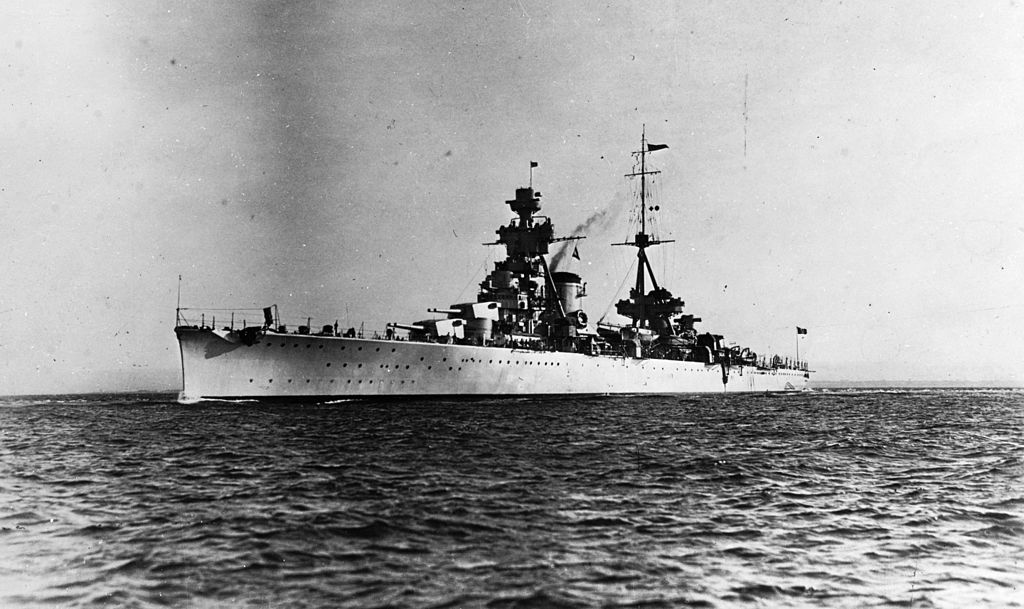
Cruiser Trieste in 1930
Genesis
The Regia Marina began design studies for heavy cruisers, and specifically the future Trento class in 1923. The preliminary work was headed by General Filippo Bonfiglietti. In 1924, news arrived of the Marine Nationale (French Navy) laying down the keel of the first Duquesne-class cruisers, pushing the Regia Marina to order the new design.
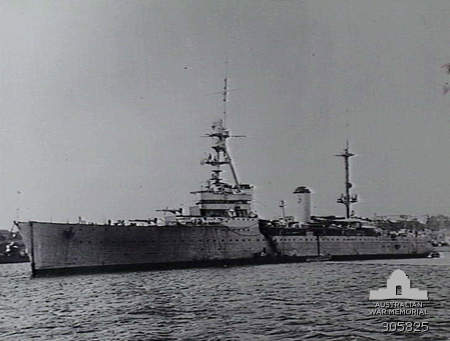
The French Duquesne (AWM)
It was very clear from the start that engineered defined a very high speed as desirable, and a way to deal with most cruisers and scout for the fleet, but required a large reduction in armor protection, save for the displacement. A narrow beam helped to achieve the high speed goal, at the expense of stability and agility. This became general pattern of Italian cruisers, until the remarkable Zara-class and later Condottieri-class which retained lessons and improved on the formula considerably, having a much more balance design.
Design
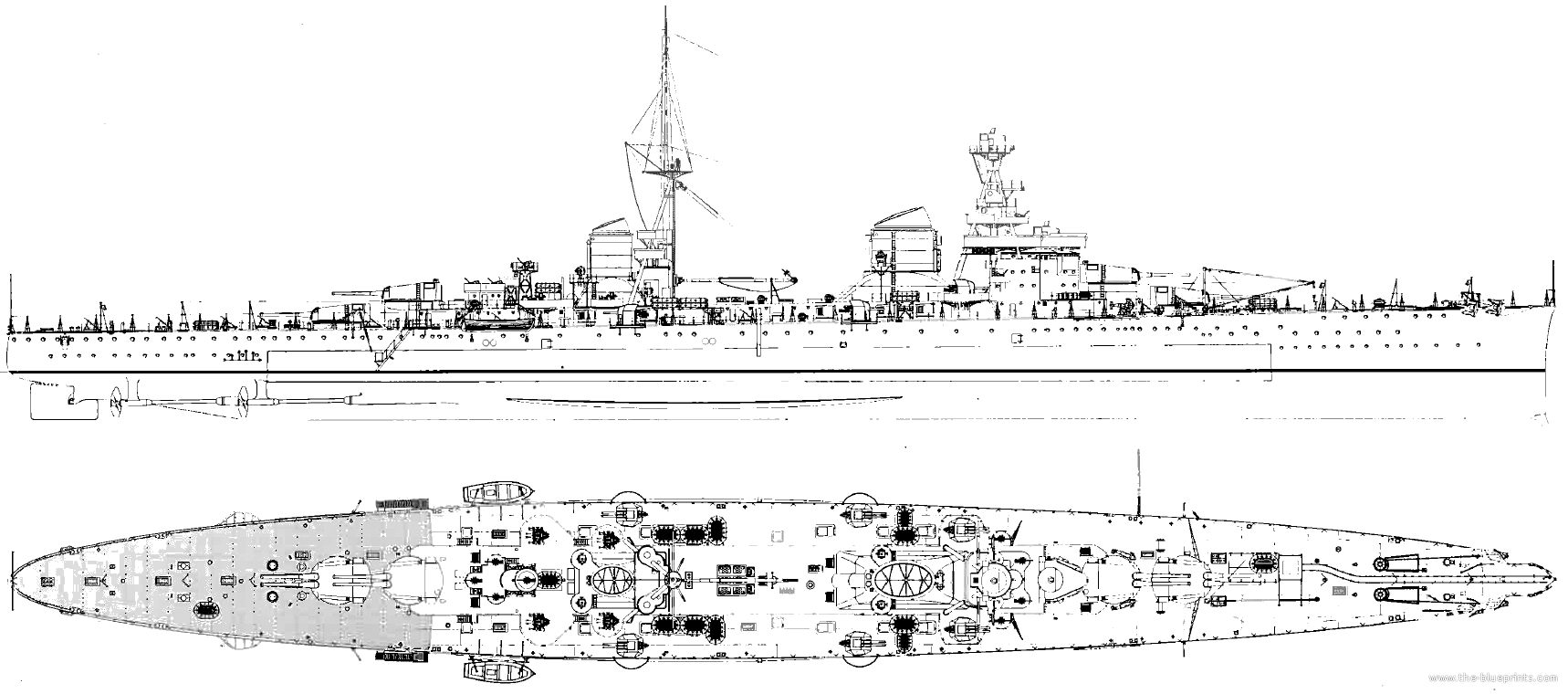
Blueprint of the Trieste class in 1942
General appearance
The Trento class were sleek, sea greyhounds. With 196.96 m (646 ft 2 in) long overall (190 meters or 623 ft 4 in between perpendiculars) for a beam of 20.6 m (67 ft 7 in) and a draft of 6.8 m (22 ft 4 in) they were long and narrow with a ratio of just 1/10, like destroyers.
Displacement, standard, was controlled and declared at 10,339-10,344 long tons (10,505 to 10,510 t) – divergence between the two ships. Fully loaded it reached 13,334 long tons (13,548 t). The most characteristic difference with older cruisers, and the light cruisers of the Giussano class, was their flush deck. Their now also had an innovation, being bulbous for the first time on an Italian warship.
The forward superstructure was supported by a tripod mast, supporting utility bridge whereas the main command bridge was just one step above the superfiring main turret. On trials the tripod would prove to vibrate excessively, which doomed all precision fire control and targeting devices. During a post-trial refit, the foremast was strengthened with two extra legs. The peacetime crew comprised 723 men, increased to 781 in wartime.

Italian heavy cruiser Trieste
Propulsion of the Trento class
As designed, and even in initial plans, the yard claimed it was possible for the ships to reach 40 knots, something unheard of in 1924. However, with the Washington standard tonage in mind and design revisions, some compromise led to use a reduced powerplant in the available space. This was compensated by revisions in beam, the flush-deck configuration and considerable work done in basins with hull’s models to nail the perfect shape.
The definitive powerplant comprised four Parsons steam turbines. They were powered by twelve oil-fired Yarrow boilers. The latter were trunked into just two funnels of unequal size. The largest was forward, and the smallest aft, with the aft tripod mounted just in front. The boilers rooms were compartimented into three sections, each containing four boilers: Two for the forward engines (outboard propellers) and two for the center shafts. The powerplant was rated at 150,000 shaft horsepower total (110,000 kW). The final speed design was marked at 36 knots (67 km/h; 41 mph), light. However in service conditions and fully loaded, normal use of the powerplant, 120,000 shp (89,000 kW) was the projected figure, which gave a more reasonable 34 knots (63 km/h; 39 mph) at the optimal displacement.
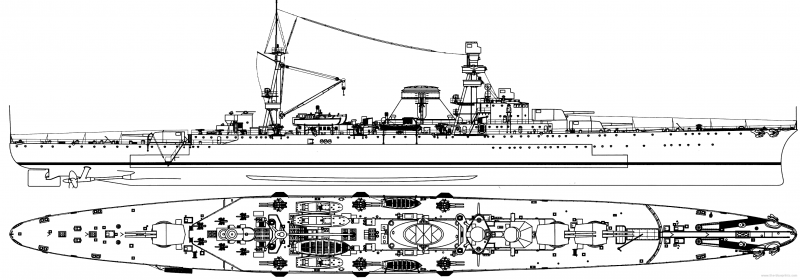
OTO shipyard’ ARA Almirante Brown, heavily inspired by the Trento design
Sea trials showed Trieste reaching 35.65 knots (66.02 km/h; 41.03 mph), Trento 34 knots, on the very light displacement. Eventually in service this practical top speed was reduced31 knots (57 km/h; 36 mph), notably after strengthening the ship due to excess vibrations. Storage capacity was 2,214 metric tons of fuel oil. Cruise range at 16 knots (30 km/h; 18 mph) was established to 4,160 nautical miles (7,700 km; 4,790 mi). This was not considerable, but standard for Italian ships, operating close to the Peninsula. In early 1940 a refit saw the fitting of funnel caps. This was due to reduced smoke interference with masts directors and observation bridges.
Protection of the Trento class: Controversy
Blueprints were approved, but soon, as both keels were on the slipways and welding too place for building the hull, some officers in the Regia Marina were concerned about the particularly thin armor. They saw it as a disadvantage in combat. They were heard ultimately, but years after and the naval staff would ordered the Zara-class, after a transitional Bolzano that was already improved.
No significant change was made however on the Trento class as it was far too advanced. The same design at that time was also chosen by Argentina for the Veinticinco de Mayo class cruisers. It was prepared by Odero Terni, in Orlando. Basically they were scaled down versions, with even thinner armor and downgraded artillery to the unusual 190-millimetre (7.5 in) caliber.
Concerns of the Navy however echoed on the plans revision for the Bolzano started in 1930.
The Trento had standard a box armor extending from the second to the third main turret, closed by bulkheads, 60 mm (2.4 in) in thickness, the belt 70 mm (2.8 in), decks 20 to 50 mm (0.79 to 1.97 in), whereas the turrets were protected by 100 mm (3.9 in), as the conning tower.
The vertical armored belt ran from 8 m (26 ft) forward of the first main turret to 5 m (16 ft) aft of the rearmost main turret. The bulkheads thickest part was only on the upper portion, the forward bulkhead lower section was just 50 mm (2.0 in). The aft bulkhead one was thinner, at 40 mm (1.6 in). The central portion of the deck was 50 mm, but i was thinned down to 20 mm (0.79 in) aft, but still had 30 mm (1.2 in) slopes along the “box”. It did not however extend forward of the citadel. The gun turrets had 100 mm (3.9 in) faces, but the barbettes rings were 70 mm thick above the deck, 60 mm below. The conning tower roof was 50 mm thick and the control director above had 80 mm (3.1 in) sides, 60 mm roof.
These figures bring some controversy, not at the time, but later, as the Washington treaty in some way obliged such compromises. This was also a trend of the time, the speed fad was to endure until 1933. 100 mm was barely enough, with a few artificial millimetres provided by the relative slope, and high-tensile hardened steel use, to stand the impact of a 6-in round. Speed was indeed 36 knots, which was way above anything known in WW1, for battlecruisers or even scouts. This was destroyer speed, and it was believed in 1924, primitive ballistic computers would be unable to readjust calculations for such as fast target. However with quick progresses in late mechanical and early electronics in WW2, this would prove it irrelevant.
In addition, to combat excessive vibrations, considerable strengthening of the hull and masts would add extra tonnage, and eventually reduce the top speed down to 31-32 knots, negating about any benefit of the initial design.
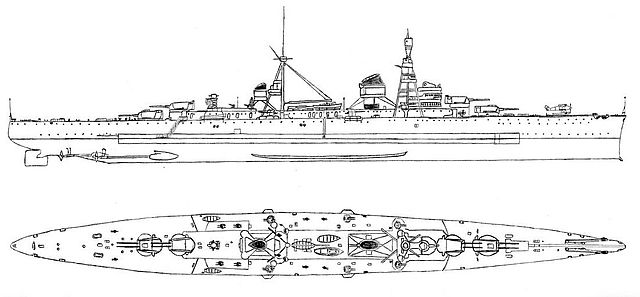
Armament of the Trento class
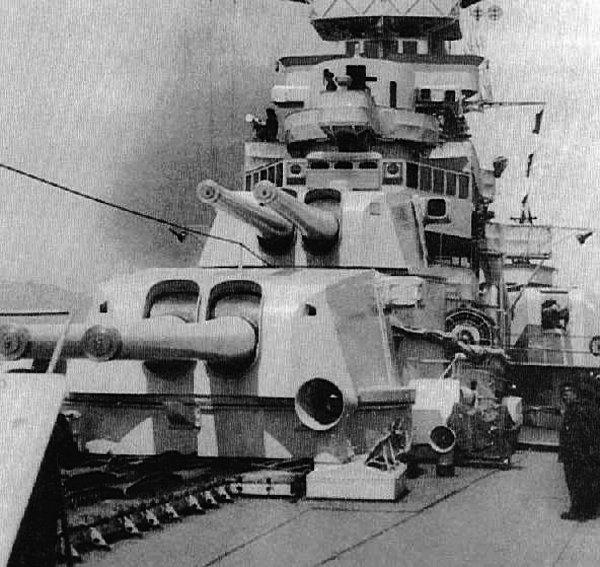
Forward superfiring turrets on the Trieste
Main armament
With the standard 8-in caliber and practice of the time, the conventional solution of four twin turret, in two superfiring and deck positions was chosen. This allowed the greatest possible arc of fire forward and aft and full broadside as well with little interference. The great lenght of the hull also allowed this “spread” of four turret holes without compromising too much the deck structure.
These 203 mm Mod 24 50-caliber guns were in single cradles, in opposition to the simpler twin mounts adopted for the light cruisers. These allowed an elevation to 45 degrees for a maximum range of 27,000 meters (30,000 yd). The rate of fire was rated as three rounds per minute, due to the obligation of returning to a 15 degrees elevation to reload. Traverse and elevation was electrically operated, including the ammunition hoists.
As noted in gunnery trials later, The guns suffered from excessive shell dispersion. They fired two types of shells: The 125-kilogram (276 lb) model (muzzle velocity 905 mps (2,970 ft/s)), with separated propellant charge. Another later model was reduced to 118 kg (260 lb) but at a lower, 840 m/s (2,800 ft/s) muzzle velocity (reduced charge). The idea was to tighten shell grouping, but this was largely unsuccessful.
The issue analysed later was the poor quality control of ammunition. Tight manufacturing tolerances was not possible and therefore this has an impact on accuracy. The other reason was the design itself, with compromises made over the position of the two single cradle mounts. They were indeed very close together. Interfere resulted of this between shells in flight. The Fire control system however was standard, also British in origin, two pairs of Barr & Stroud 5 m (16 ft) coincidence rangefinders installed fore and aft, to serve both turret groups, three on the forward tripod and a single one on the superstructure aft.
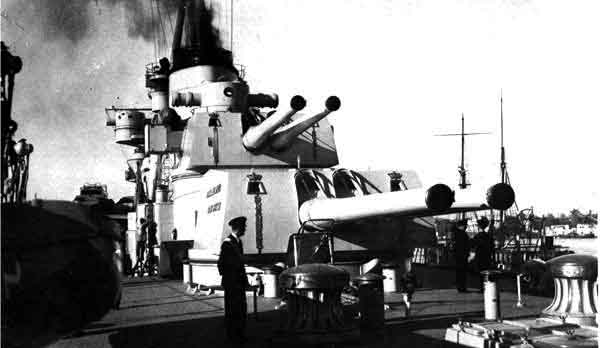
Artillery aft, Cruiser Bolzano (cc)
Secondary and AA armament
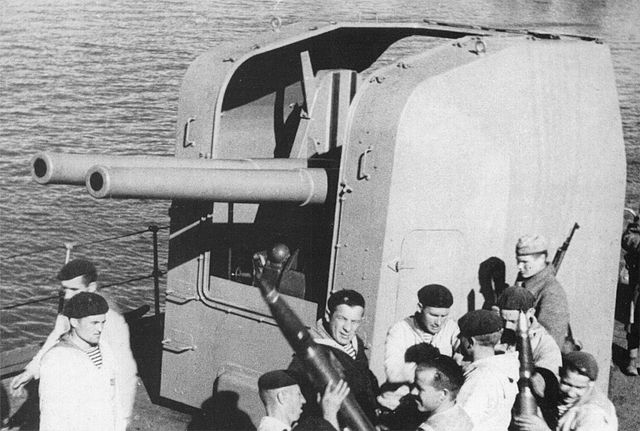
The first stage was a group of sixteen (8×2) dual-purpose 100 mm (4 in) 47-caliber guns. They were in twin mounts, copies of 1910 Austro-Hungarian guns (Škoda) placed in modern mounts allowing for a 85 degrees elevation, traduced into a maximum range of 15,240 m (50,000 ft). They were placed on the deck, two pairs and the remainder on the forward and aft decks, protected by enveloping masks. Fire control was provided by secondary telemeters
This was completed by four Vickers-Terni 40 mm/39 guns, all in single mounts, and at last the very close bubble was secured by four 12.7 mm (0.50 in) Breda heavy machine guns.
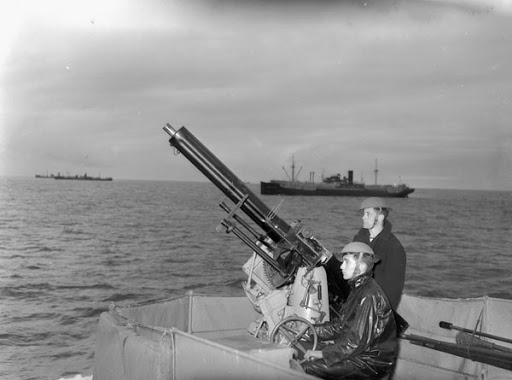
Vickers-Terni 40 mm/39 guns – src Navweaps.com
For close quarters, the transalpine cruisers carried four twin 533 mm (21.0 in) torpedo tubes launchers inside the hull, fixed and above water. For observation, a large rotating aircraft catapult was placed amidships right between the two funnels where the seaplanes could be managed by the main mast boom crane. The ships had a deck hangar capable of housing two IMAM Ro.43 seaplanes used for aerial reconnaissance, SAR and artillery spotting. A third could be mounted on the catapult.
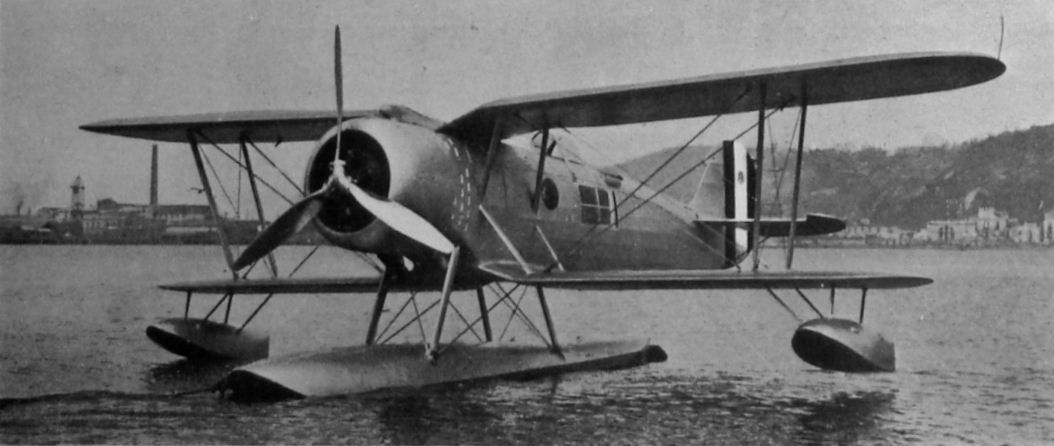
Later refits will saw the AA artillery revised several times. The 100 mm guns replaced by Mod 31 versions in 1932 and in 1937–1938, second aft 100 mm pair was deposed as four 12.7 mm machine guns. In replacement, eight 37 mm (1.5 in) 54-cal. Breda M1932 guns in twin mounts (so four) and eight 13.2 mm (0.52 in) Breda M1931 heavy machine guns (same) were installed. In 1942, Trento was given four extra single 20 mm (0.79 in) 65-cal. Breda M1940 and her sister ships eight in 1943. By that time their bridge and other details has been modified too.
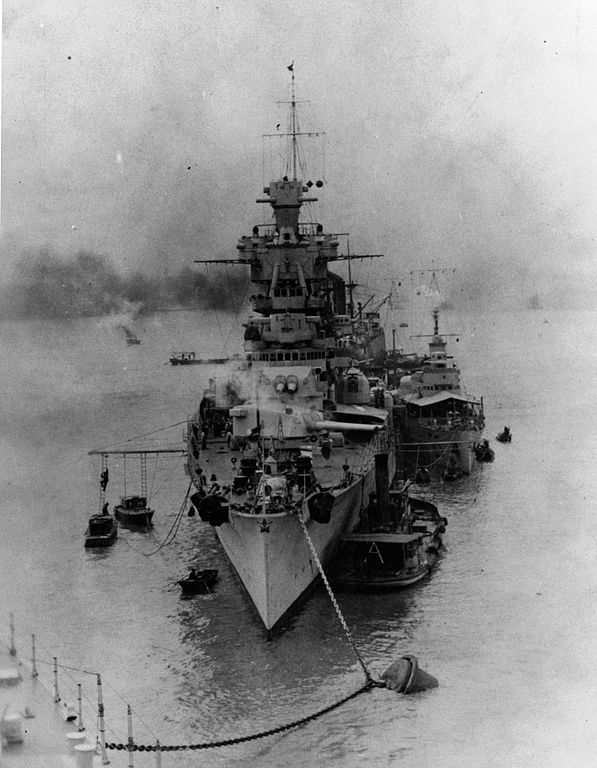
Cruiser Trento, bow view
Technical specifications (Trento)
Displacement 10,340 t. standard -13,330 t. Full Load
Dimensions 197 m long, 20.60 m wide, 6.80 m draft
Propulsion 4-screw machines, 4 Parsons turbines, 12 Yarrow boilers, 150,000 hp. Maximum speed 36 knots
Protection Belt 70, bridge 50, turrets 100, blockhouse 100 mm
Armament 8 guns of 203 (4×2), 16 guns of 100 (8×2), 4 of 40 AA, 8 of 13.2 AA, 8 TTs 533 mm (4×2 flanks)
Crew 780
Bolzano, the modified Trento
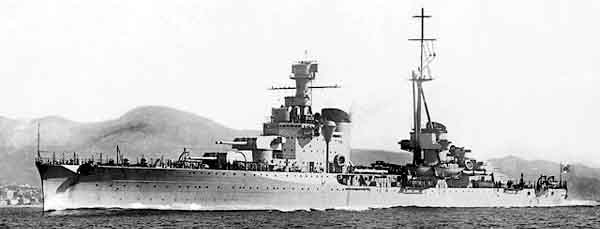
Official Yard photo of the Bolzano, soon after completion
The Bolzano was ordered under the 1929–1930 construction program, as a time the admiralty wanted two divisions of three heavy cruisers each. The idea was to allow at a division to be least two-cruisers strength when the third was in drydock. However the Pola (Zara class) was chosen instead, but under pressure of Gio. Ansaldo & C. yard for a construction contract, the admiralty was pressed to pass an order, and to gain time a development, this became a third modified Trento, at the time the Zara design was completed.
The new design incorporated improvements from the Zara design indeed. This included a longer 203-millimeter (8.0 in) main gun and more powerful boilers, and crucially a stepped up forecastle deck instead of a flush deck hull. The Regia Marina staff however insisted for speed over protection, so armour scheme was similar to the Trentos. Therefore sailors would later say about the new ship “un errore splendidamente riuscito”: an error beautifully executed.
The hull length was slightly shorter as well. Bolzano’s keel was laid down in June 1930. She would be commissioned in August 1933, like the last of the Zara class, and among the last Italian heavy cruisers (the tonnage was capped by the London treaty).
Bolzano’s war career was relatively uneventful in peacetime, but in WW2 she participated in the Battles of Calabria, Taranto, Cape Spartivento, and Cape Matapan. She was lightly damaged at Calabria, but spared on other occasions, escorting convoys and patrolling in the central Mediterranean, torpedoed twice by British submarines. In July 1941, this cost her three months of repairs, and in August 1942, this ended the her career. Repairs stalled at la Spezia and she was destroyed by Chariots in June 1944.
Design of Bolzano
Outside of the hull, the Bolzano also differed by its superstructure, which was entirely revised: Instead of stacked bridges around a tripod, she has a single massive structure which wrapped the tripod mast, bridges, and front funnel and was appreciated as larger and roomier. Lessons were learned since the first Trentos and even the Zara class (but Gorizia).
Her hull was slightly shorter at 187.6 meters (615 ft) between perpendiculars, 196.9 m (646 ft) overall but with the same beam of 20.6 m (68 ft) and 6.8 m (22 ft) draft. Her standard displacement was 10,890 long tons (11,060 t), 13,665 long tons (13,884 t) fully loaded. Despite having the same tripod masts as the Trentos, the fore mast was englobed in the superstructure but its role was unchanged, carrying the armoured Barr & Stoud fire directors. She also had a large, rotating aircraft catapult amidships between the funnels like the Trentos, with room for up to three IMAM Ro.43 seaplanes.
Powerplant
It was essentially the same as for the Trentos, with a four cells compartmentation, four Parsons geared steam turbines, four screw propellers, but ten brand new oil-fired water-tube boilers. They were trunked the same way, and spread between two unequal, raked, widely spaced funnels (for wich caps were added in 1940). Total output was 150,000 shaft horsepower (110,000 kW), as a result on paper, top speed was 36 knots (67 km/h; 41 mph). Speed trials, light (10,847 long tons), 36.81 knots was achieved by forcing heat at 173,772 shp (129,582 kW). In service, 30-32 knots was more common. Electricity came from two generators generating a total of 1,080 kilowatts (1,450 hp), running barbettes, turrets, fire directors, etc.
Armament
Bolzano was armed with the same type of main battery, 2×2 superfiring turrets fore and aft, but with longer 203 mm (8.0 in) Modello 1929, 53-caliber. The cradles and mounts were the same, resulting in the same dispersion and lack of accuracy as the Trentos.
The initial Anti-aircraft battery rested on the same pattern as the Trentos: Sixteen 100 mm (4 in) 47-cal. guns, all in twin mounts, and four Vickers-Terni 40 mm/39 guns in single mounts. This was completed by eight twin Breda 13.2 mm (0.52 in) heavy machine guns. For close quarters, she also had two twin 533 mm (21.0 in) fixed above-water launchers per side.
Like the Trentos, the rearmost 100 mm guns were removed, eight 37 mm (1.5 in) 54-cal. guns installed and the eight 13.2 mm (0.52 in) guns replaced with four 20 mm (0.79 in) 65-cal. AA guns in 1942.
Protection
The same scheme as the Trentos was reproduced: The armored belt was 70 mm (2.8 in) thick and the citadel closed by with armored bulkheads, 60 mm (2.4 in) forward, and 50 mm (2.0 in) aft. The main armored deck was 50 mm thick in the central citadel (starting from the forward and aft barbettes), down to 20 mm (0.79 in) on the hull’s ends. The gun turrets faces were protected by 100 mm (3.9 in) of armor, with 60–70 mm walled barbettes. The forward main conning tower had 100 mm walls, 40 mm roof like the Trentos again.
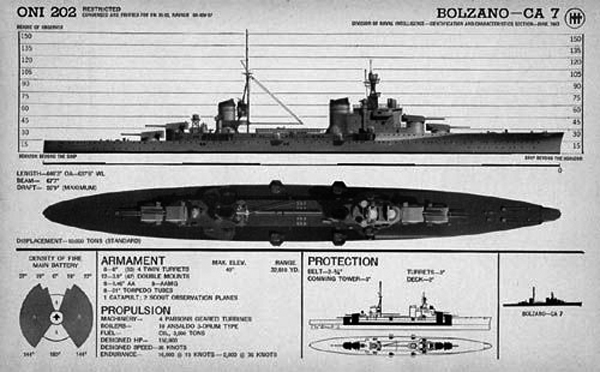
ONI – Bolzano
Features: (Bolzano, 1940)
Displacement and dimensions: Tonnage 10,886 – 13,865 PC, 197 x 20.60 x 6.80m.
Propulsion and performance: 2 Parsons turbines with reducers and 10 Yarrow boilers, 2 propellers, 150,000 hp and 36 knots
Protection: 50 mm bridges, 70 mm belt, 100 mm turrets, 100 mm blockhaus
Crew: 780
Armament: 8×203 mm (4×2), 16x100mm (8×2), 4x40mm, 8x13mm AA, 2×4 TT 533mm.
Gallery – details of the Trento, 1942
Operational Career
Their wartime career was short but very active. Trieste and Trento participated in the Battle of Cape Matapan, while Trento fought off Calabria in July 1940, and second battle of the Great Sirte (March 1942) sunk by HMS Umbra o, June 15, 1942 while Trieste was torpedoed in November 1942 HMS Utmost, but survived to be sunk by the RAF in Sardinia in April 1943. Bolzano participated in four battles, but was torpedoes two times, the second one almost fatally.
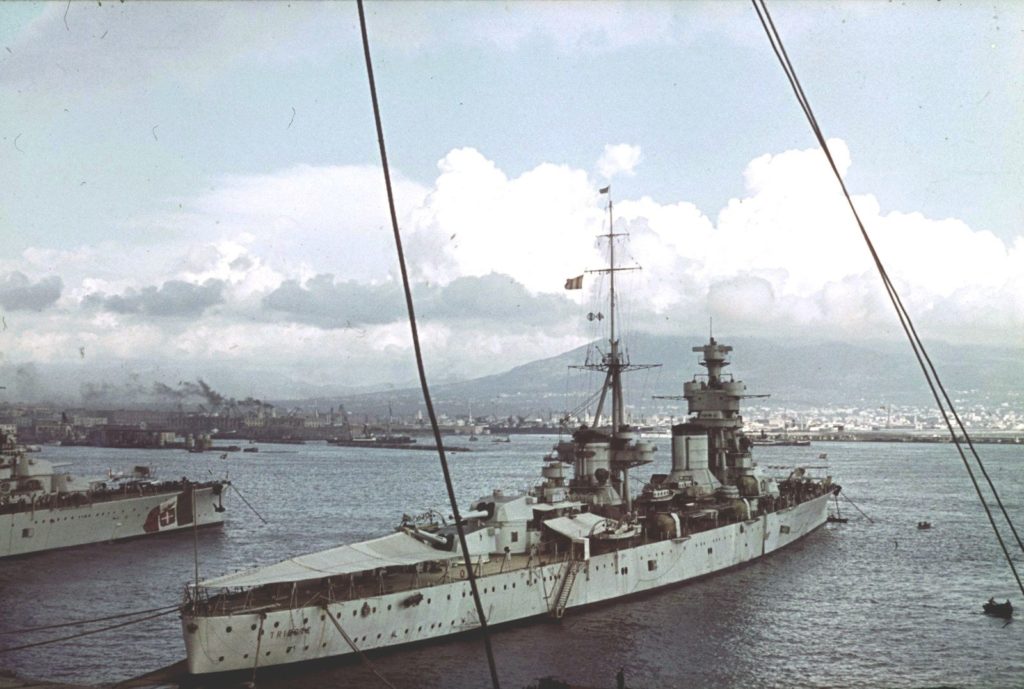
HD color Photo of the 3rd cruiser division – Unknown origin (pinterest);
Trento in action
Launch & cmmission
The story of Trento started with a delayed launched, initially planned for the 4 September 1927. A sabotage from shipyard’s anti-fascist workers mixing sand with grease in the slipway, stopped it to reach water. Eventually the yard’s direction ordered to drag the cruiser to the sea on 4 October 1927, towed by the SS Principe di Udine.
She was commissioned on 3 April 1929 and became the flagship of the Cruiser Division, cruising the northern Mediterranean with the Trieste. Their first stop was Barcelona. From July, Trento headed for South America and visited Cape Verde, Rio de Janeiro, Santos, Montevideo, Buenos Aires, Bahía Blanca, Las Palmas, and back to the Mediterranean, Tangiers, and home on 10 October.
Interwar service
In September 1930, she made another cruise, this time in the eastern Mediterranean. By mid-1931, she was in drydock in La Spezia to strenghten her tripod foremast, with a sturdier five-legged version. From January 1932 she teamed with the destroyer Espero to carry a contingent from the San Marco Battalion bound for China (Italian Far East Division).
There, she joined the old protected cruiser Libia and gunboats Caboto and Carlotto to protect Italian nationals during the Chinese Civil War. They stopped en route to Colombo, and Singapore and ended in Shanghai on 4 March. In May, she departed to Japan, visiting Nagasaki, returned to Shanghai and departed for Italy.
In July 1933, Trento was part of a major fleet review in the Gulf of Naples and she became the flagship of the 2nd Division and from July 1934, flagship of the 3rd Division. She toure eastern Mediterranean again until March 1935, stopping notably at Rhodes and Leros. In November 1936 she participated in another review for the Regent of Hungary, Miklós Horthy. In March 1937, she escorted Mussolini onboard Pola for a trip to Libya and she stopped at Benghazi, Tripoli, and Ra’s Lanuf.
She was in another fleet review in 5 May 1938 for Adolf Hitler’s state visit and in May 1939 for Prince Paul of Yugoslavia. In June, the fleet was in Livorno (first Navy Day) and she toured the eastern Mediterranean and back to Taranto in July.
Trento in WW2
In October-December, when the war broke out, she was in drydock for a refit, with armament modifications, funnel caps installed and other alterations. By June 1940, Trento was in Messina as flagship of the 3rd Division. She joined the 6th Division and the combined force patrolled the Strait of Sicily, laying a minefield.
On 8 July, her division escorted a convoy to Libya, together with the 1st Division battleships. Their return trip saw them encountering a protected British convoy, which resulted in the Battle of Calabria.
At this occasion, Trento duelled with British cruisers but the RAF attacked her several times, but she emerged unscathed. After the forces disengaged, air reinforcements arrived, but pilots mistook the Italian ships for British ones and attacked, before realizing their mistake. This episode resulted in the admiralty to impose the painting of red stripes on white on the forecastles and poor decks of all major Italian vessels to avoid future confusion.
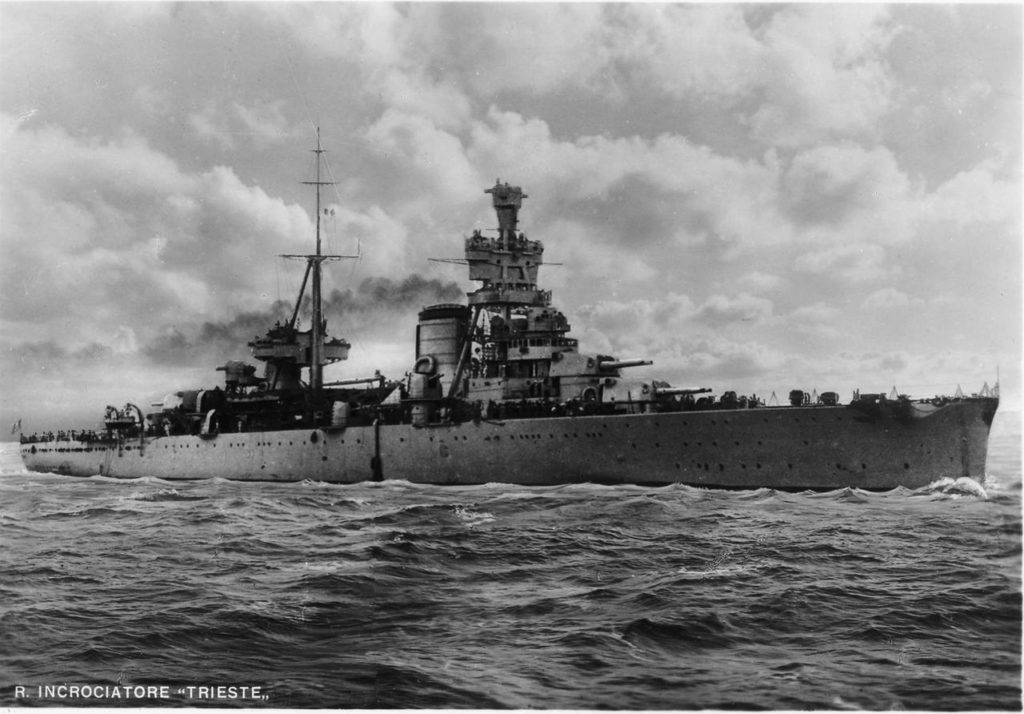
HD photo of the Trieste at sea, unknown origin (Pinterest)
Trento escorted another convoy to Libya, and was back to Messina on 1 August 1940. She sortied to try to catch a British convoy (Operation Hats) but was recalled off without spotting any ship.
On 12 October, Italian destroyers accompanied by torpedo boats attacked British cruisers in what was the Battle of Cape Passero. Artigliere, was badly damaged and the 3rd division (Trento, Trieste, Bolzano) was called as a reinforcement, but failed to reach the British cruisers already far away.
On their return, they were attacked by the RAF, but without success. On 21 October, Trento moved to her new operating base at Taranto, closer to action. During the night of 11–12 November, Fleet aor arm planes attacked the base, causing mayhem. On bomb did hit the Trento but fortunately, failed to explode, but damaged the port forward 100 mm mount.
On 26 November, Trento rushed to intercept a British convoy to Malta and a Bolzano’s IMAM seaplane successfully located the British squadron. Vice Admiral Inigo Campioni however became frightened by the strength of the British fleet and ordered a retreat, but the order came too late for the 3rd division, already engaged with British cruisers in what became Battle of Cape Spartivento. Trento actually scored two hits on the cruiser HMS Berwick (County class). But the success was cut short by the closing of the battlecruiser HMS Renown. Campioni was forced to send the battleship Vittorio Veneto to help the cruiser retreating, and the British breok off and both fleet disengaged.
The Trento at the the Battle of Cape Matapan
Probably the greatest involvement of the the 3rd Division so far. This happened after Trento and her sister ships escorted a convoy to North Africa on 12–13 March 1941. On 27 March, the division, now under Rear Admiral Luigi Sansonetti headed for the island of Crete, hoping to catch a British convoy. At 06:55 on 28 March, Vittorio Veneto’s IMAM Ro.43 located a British cruiser squadron. At 07:55, the 3rd Division spotted them and scrambled combat preparation. 17 minutes later they opened fire at 24,000 yd (22,000 m). For Forty minutes, Trento fired 204 AP shells on the British ships but filed to score significant hits. This demonstrated both the extreme dispersion of the fire and poor accuracy, compounded by the distance.
At 08:55, Vice Admiral Angelo Iachino ordered Sansonetti to retreat and head northwest, to lure the British cruisers towards Vittorio Veneto. At 11:00, the later was close enough to open fire, and the three cruisers returned to close the gap and fire against the British cruisers, armed with 6-in guns. They quickly broke off and retreat. However soon after British torpedo bombers from Crete attacked the Trento and her division at around 12:00, soon reinforced by planed from the carrier HMS Formidable. Iachino decided to break off 20 minutes later.
Trento, Trieste, and Bolzano escaped without damage and they reached Taranto, escorting the damaged Vittorio Veneto, but meanwhile the immobilized Pola soon reinforced by the two other Zara-class cruisers were destroyed during the night by British battleships, which made the battle a clear victory for the British.

Detail of the bridge, 1935 – src: history-navy.mil
Convoy operations (1941-42)
Trento was at La Spezia in May for an overhaul until 5 August, and returned to Messina for escort missioned. She escorted the Duisberg convoy on 8–9 November (with Trieste), being attacked by by British warships on their way, and failed to protect the convoy. On 21 November 1941 another convoy saw Trento fending a British air attack. On 16 December, she escorted two large convoys to Benghazi and Tripoli. The day after, they met a British convoy, leading to the inconclusive First Battle of Sirte.
The rest of the year was uneventful, and Trieste was protecting other convoys in January and February. However on 22 March 1942, she teamed with the battleship Littorio, and the only Zara-class left, the Gorizia, plus the light cruiser Giovanni delle Bande Nere and destroyers. The combined fleet was sent to intercept the British convoy MW10, and this became the Second Battle of Sirte. The four British light cruisers and eighteen destroyers managed to held off the Italians and saved the convoy, but Trento apparently scored a hit on HMS Kingston while on the Italian side, Lanciere and Scirocco were lost during a storm after the battle, and Trento failed to reach them.
On 14 June, Trento headed from Taranto with the battleships Littorio and Vittorio Veneto, and the cruiser Gorizia, light cruisers Giuseppe Garibaldi and Emanuele Filiberto Duca d’Aosta. Thir target was a British convoy from Alexandria, bound to Malta (Operation Harpoon). While steaming in the Ionian Sea, she was attacked by a Beaufighter around 05:00 and took a torpedo hit. This started a wild fire in the forward boiler rooms, soon flooded. Trento was stopped, destroyers laying a smoke screen to hide her from other attacking planes. The same detroyers attempted to tow her back, but she was a sitting duck, and an esy prey for submarines. At 09:10, HMS Umbra spoted her and launched torpedoes that crippled the Trento. These were not aviation torpdoes but standard 21-in ones, with an explosive power almost double.
As a indirect result of the impact, Trento’s forward magazines exploded, causing the hull to rupture and she sank in a few minutes carrying with her 549 men, including Captain Stanislao Esposito. 602 men were rescued by destroyers however, 21 died of their wounds later; She was only struck from the naval register in 18 October 1946.
Trieste in action
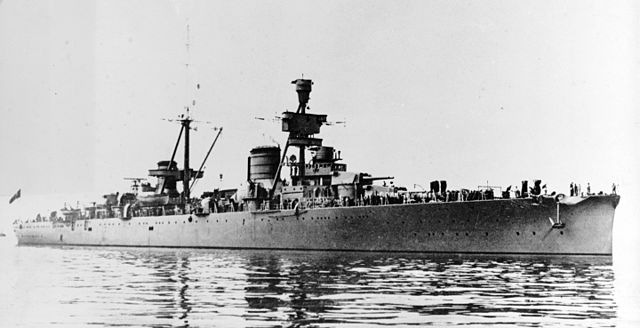
Trieste as built
Interwar
Was laid down at the Stabilimento Tecnico Triestino on 22 June 1925, launched on 24 October 1926, a year before Trento but fitted-out and commissioned on 21 December 1928. She joined on 16 May 1929 the 1st Cruiser Division and cruised the northern Mediterranean until 4 June. In October, she became the flagship of the 1st Squadron and was overhauled in May or June 1931 in La Spezia for the same reasons as her sister ship. In July 1933, she participated in a review in the Gulf of Naples and on 2 December 1933, her unit became the 2nd Division, 1st Squadron, then 3rd Division in July 1934 as the Zara class formed the 1st division.
She became in June 1935 the divisional flagship as Trento was sent in drydock maintenance. In March 1937, she escorted Mussolini in Libya, and in June took part in another major naval review for German Field Marshal Werner von Blomberg. In February 1938 she became the 2nd Squadron flagship and in May, departed for the Gulf of Naples for a review destined to Adolf Hitler. In October she left her operating based in Messina with the 10th Destroyer Squadron to join an Italian convoy in Cadiz, Spain.
She embarked 10,000 men, of the Italian volunteers, the Corpo Truppe Volontarie supporting General Francisco Franco. After another naval review in May 1939 she headed for Livorno’s Navy in June. She was in refit when the war started.
1940 Battles
When Italy declared war on Britain and France, Pola has replaced Trieste as squadron flagship, 3rd Division. At last, the division (also Trento and Bolzano) patrolled north of Sicily and launched their first convoy hunt in August to Malta (Operation Hats). Trieste was attacked during the night of 11–12 November in Tarento by swordfish but was not hit as the latter concentrated on battleships.
On 26 November the division attempted to intercept another convoy, and soon after the Battle of Cape Spartivento broke off, relatively indecisive. Trieste scored at least one hit on HMS Berwick, however HMS Renown arrived and concentrated Trieste, which had two near-missed and had only splinter damage. In February 1941, Trieste sortied with 2nd Squadron, searching for Force H returning from Genoa waters. In mid-March, she escorted a convoy to North Africa.
On 27 March, she participated in the Battle of Cape Matapan, opening fire from afar and spending 132 AP shells, mostly with little results. She was latter attacked by torpedo bombers from Crete but escaped whereas Pola did not had that chance. Trieste, Trento, and Bolzano were attacked again while returning as the night fell. Disaster struck the first division later.
Convoy season (1941-42)
In April 1941, Trieste and Bolzano escorted a convoy to to Tripoli, but never arrived there. Because of the weather and Royal Navy threat they took shelter in Messina; They paired for another convoy in June, with destroyers Corazziere, Ascari, and Lanciere. She later teamed with Gorizia and 12th Destroyer Squadron, finding heavy British night air attacks. They reached Tripoli and the fleet was back to Taranto on 1 July.
She teamed with Bolzano, Ascari, Corazziere, Carabiniere for another convoy to Tripoli in late July and in late August, she tried to locate Force H and would intervene later during Operation Halberd on 26 September. Later she escorted the Duisberg convoy (8–9 November), which was lost due to heavy attacks.
Another convoy took place, this time to Libya on 21 November, where Trieste teamed with Duca degli Abruzzi. They were awaited by a combined submarine and aircraft attack at dusk. Trieste was torpedoed by HMS Utmost, while a torpedo bomber hit Duca degli Abruzzi but the two vessels managed to get back to Messina, escorted by Giuseppe Garibaldi and the destroyer Bersagliere. After repairs, Trieste was back in the 3rd division, with Bolzano and Gorizia, which was added to eight destroyers and departed in August 1942 to intercept a British convoy but the operation was cancelled after Bolzano was torpedoed, as one destroyer.
Fate (April 1943)
On 10 April 1943, Trieste was mostly inactive since months at La Maddalena, Sardinia. A raid of B-24 Liberator heavy bombers attacked the docks. She was hit several times at 13:45. The damage of these heavy bombs was so severe that she capsized at 16:13 to starboard and sank. Most of the crew were not on board or had time to escape, but still, she ship trapped 66 men including 10 officers, and about the same number wounded.
Trieste was maintained however on the naval register until 18 October 1946 as there were hopes to salvage and repair the sunken cruiser, which never materialized. At this stage Italy has already collapsed and the Germans never had the manpower or equipment to do so. Sardinia by then was under command of General Frido von Senger und Etterlin. Salvage operations started in 1950, and the hull was towed La Spezia to be inspected. It was realized the leaking oil napped and wrapped the engines, which were miraculously preserved from salt water. When dried up, the ship was partly cleaned up when the Spanish Government expressed the will to purchase the hull for conversion into a light aircraft carrier in Ferrol in 1952. However the budget was never there and the hull was broken up in 1959.
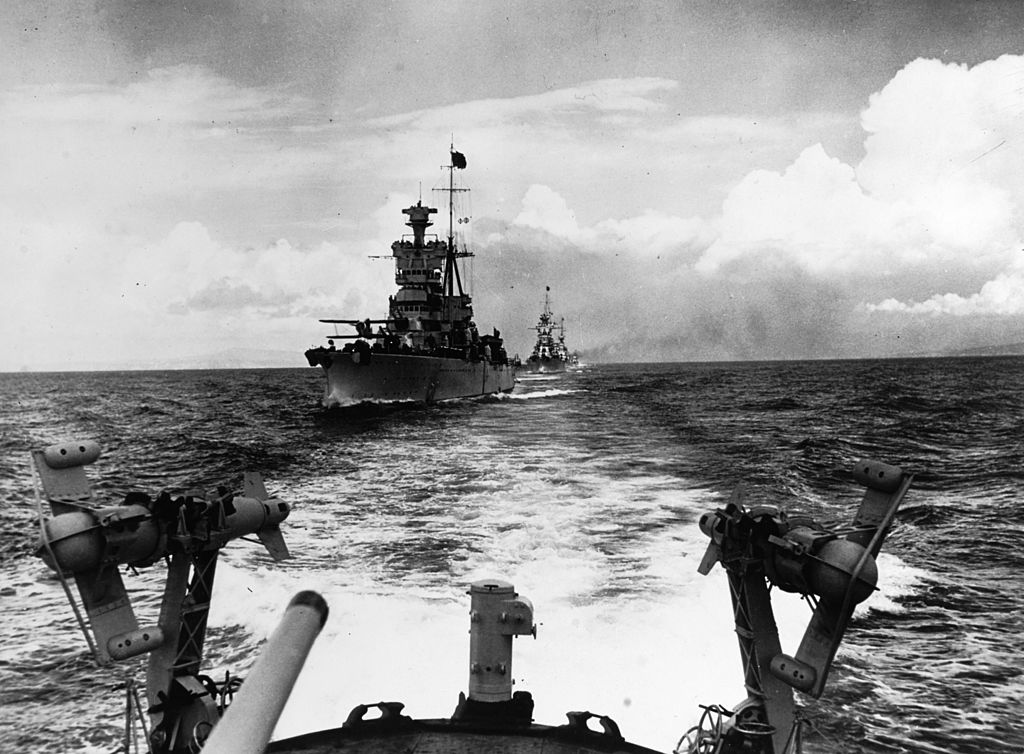
Trieste and Trento in operations

Author’s illustration of the Trento class
The Bolzano in action
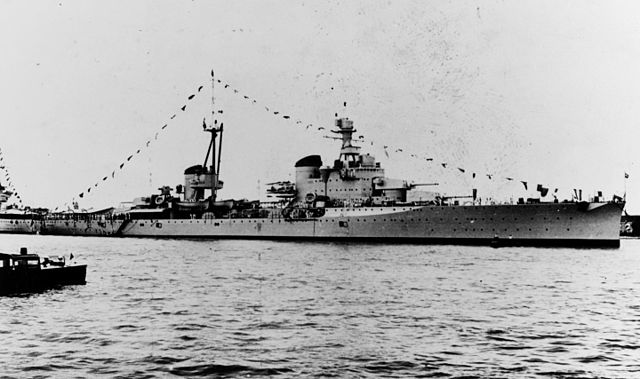
Bolzano before the war
The Heavy cruiser Bolzano’s construction followed the four Zara. She differed from her earlier sisters, but still was woeefully underprotected. Her keel was laid down at Ansaldo, Genoa, 11 June 1930. Bolzano was was launched on 31 August 1932, completed on 19 August 1933 and commissioned. In December she was part of the 2nd Division, the 1st Squadron (The Zara class formed the 1s division by then). Her unit became the 3rd Division and she took part in a naval review in 1936 for the regent Miklós Horthy, and later escorted the Italian dictator to Libya.
She retrieve six Italian sailors near the Balearic Islands, from the auxiliary cruiser Barletta, sunk by Republican bombers in 1938. Like her sisters she participated in two naval reviews and was visited by Mussolini when anchored at La Maddalena, Sardinia. Soon after in May 1939 she was present at another review for Paul of Yugoslavia in the Gulf of Naples and Navy Day celebration in May, Livorno.
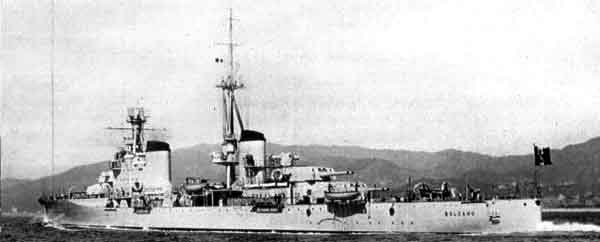
Cruiser Bolzano, stern view

Author’s old illustration of the Bolzano in 1940 for comparison
World War II
In June 1940, Bolzano teamed with the Trento and Trieste as part of the 2nd Division, 2nd Squadron and in July participated in the Battle of Calabria, engaging British cruisers British cruisers, being hit thrice by 6-inch (152 mm) shells from HMS Neptune at 16:05. She deplored two KIA and had a jammed rudder to port. This forced her in a tight circle, but this was repaired, fortunately for her as she was later attacked by Italian planes by mistake.
She was repaired at la Spezia and was present at Taranto during the night attack, but spared. Indeed, some Swordfish were loaded with bombs, intending to hit the three cruisers, but all three commanders decided to hold their fire, so to not lightened up the ships. Therefore, the Trento, Trieste and Bolzano escaped any damage. Late november, the unit departed to intercept a British convoy to Malta, which degenerated into the Cape Spartivento. Bolzano duelled with the battlecruiser HMS Renown, but none of the two scored any hit at this range.
She raided also the eastern Mediterranean in late March 1941 (Battle of Cape Matapan), evading torpedo bombers attacks. For the rest of the year, she took part in the routine of convoy escorts to Tripoli. 24–30 April, 24–27 May, on 8–9 & 25 June to 1 July, 16–20 July. However during her way back of her last convoy she was ambushed and torpedoed near the Strait of Messina, by HMS Triumph. Crippled, she was taken in two by two tugs and dragged to Messina. She was repaired for three months. She escorted another convoy to Libya on 8–9 November.
Bolzano’s 1942 torpedoing

Bolzano in 1942
In July 1942 she was visited by Prince Umberto. In August she teamed with Trieste, and Gorizia (3rd Division) and sortied to intercept a British convoy, but withdrew because of Luftwaffe’s lack of support. however on her way back, Bolzano was ambushed by another British submarine, this time, HMS Unbroken. The damage was quite severe as a fire broke out, but the crew quickly flooded the forward magazines and her captain beached her on the island of Panarea where she rested, listing 45 degrees. She was of course abandoned, a decision which saved any lives.
Nevertheless, a fire still raged until the next day, until finally extinguished by some returning crew members. She was still stranded there on 15 September, but hte hull was repared and water pumped out enough for tugs to tow her back to Naples. Temporary repairs in drydock allowed her to reach La Spezia, but the complete repair process stalled.
Conversion plans
The Regia Marina staff indeed by this point was convinced that aircraft carriers were the utmost necessity and planned her conversion into a light escort carrier hybrid.
The project went ahead, and plans were drafted and approved. They included the removal of the bridge structure and forward gun turrets, over which were located the hangar, while the forward funnel truncated exhausts were diverted to the sides.
However the proposal was doomed by a war economy which can barely repaired the cruiser, let alone convert her. Repairs resumed with little progress due to multiple shortages until early 1943, and on 5 June, USAF raids started. A squadron of American B-17 bombers raided La Spezia, but miraculously scored no hit on Bolzano. On 3 September 1943, Italy surrendered and on 8–9 September, La Spezia was captured by German troops. The cruiser was cannibalized as well as Gorizia. On 21–22 June 1944, British and Italian frogmen used ‘Chariot’ manned torpedoes and sank Bolzano and attacked Gorizia. The Germans indeed planned to use them as blockships. Gorizia however failed to sink. Bolzano was stricken on 27 February 1947, and sold for BU in September 1949.
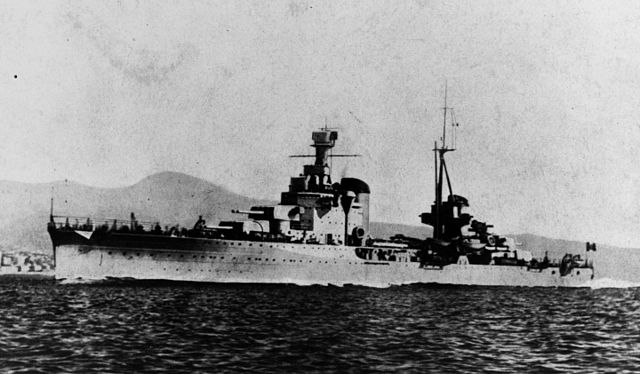
Bolzano as built
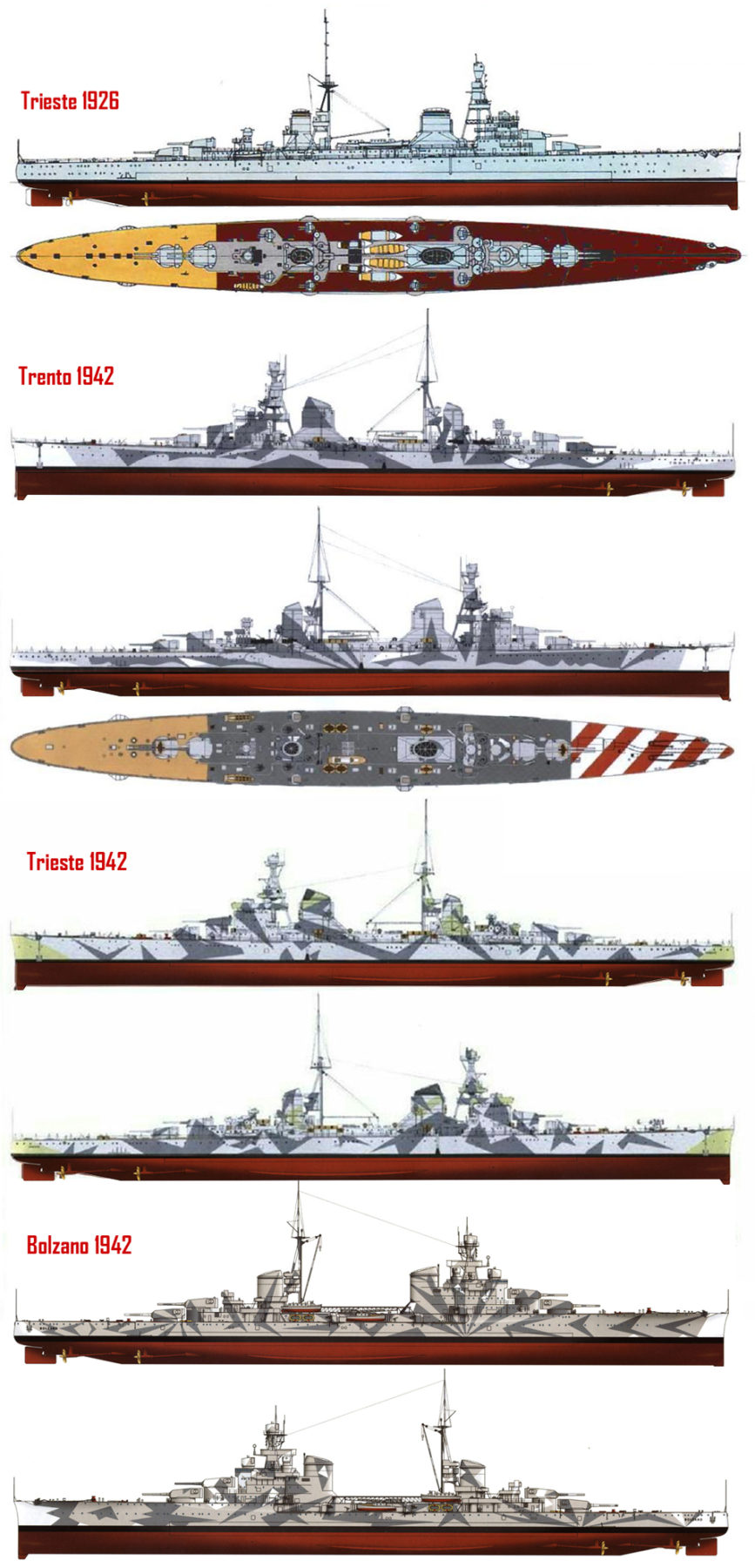
Camouflage Liveries of the Trento, Trieste and Bolzano from model kits, pinterest (montage).
Model kits available (feel free to complete this section):
Trento, Delphis Models 1/700
GHQ Model 1/2400
On SD Model Makers
Review of the Delphis model
Another review on steelnavy
EVA models 1/350 Trento 1942
Mikroflota Bolzano – Paper model kit 1/400
Read More
Gardiner, Robert & Chesneau, Roger Conway’s all the world fighting ships 1922-47
Brescia, Maurizio (2012). Mussolini’s Navy: A Reference Guide to the Regia Marina 1930–1945.
Fioravanzo, Giuseppe (1970). La Marina Italiana Nella Seconda Guerra Mondiale.
Greene, Jack & Massignani, Alessandro (1998). The Naval War in the Mediterranean, 1940–1943.
Hogg, Gordon E. & Wiper, Steve (2004). Warship Pictorial 23: Italian Heavy Cruisers of World War II.
Marriott, Leo (2005). Treaty Cruisers: The First International Warship Building Competition.
O’Hara, Vincent P. (2009). Struggle for the Middle Sea: The Great Navies At War In The Mediterranean Theater, 1940–1945.
Stern, Robert C. (2015). Big Gun Battles: Warship Duels of the Second World War.
//www.regiamarina.net/detail_text_with_list.asp?nid=71&lid=1
//www.regiamarina.net/detail_image_with_list.asp?nid=118&lid=1
//www.lonesentry.com/blog/italian-navy-ship-silhouettes.html
//fr.naval-encyclopedia.com/2e-guerre-mondiale/marine-italienne-2egm.php#crois
//www.naviearmatori.net/eng/foto-72888-1.html
//digilander.libero.it/planciacomando/WW2/gaudo2.htm
//en.wikipedia.org/wiki/Trento-class_cruiser
//www.lavocedelmarinaio.com/2017/09/10-9-1941-vincenzo-di-martino-e-la-regia-nave-bolzano/
//forummarine.forumactif.com/t4975-italie-croiseurs-lourds-classe-trento
//adhemar-marine.blogspot.com/2010/10/les-croiseurs-lourds-italiens.html
//www.culturanavale.it/documentazione.php?id=160
//www.associazione-venus.it/galleriafotografica/index.php/search?album=1&q=trento


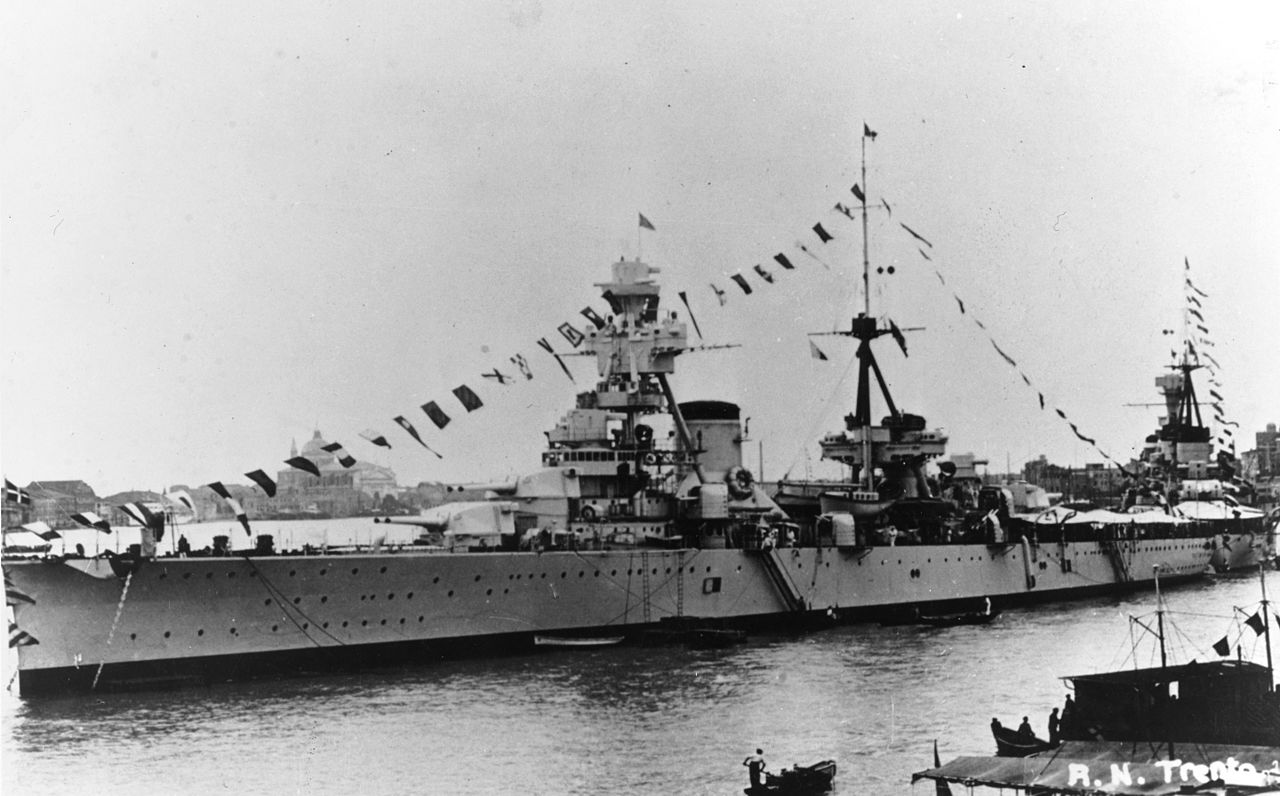
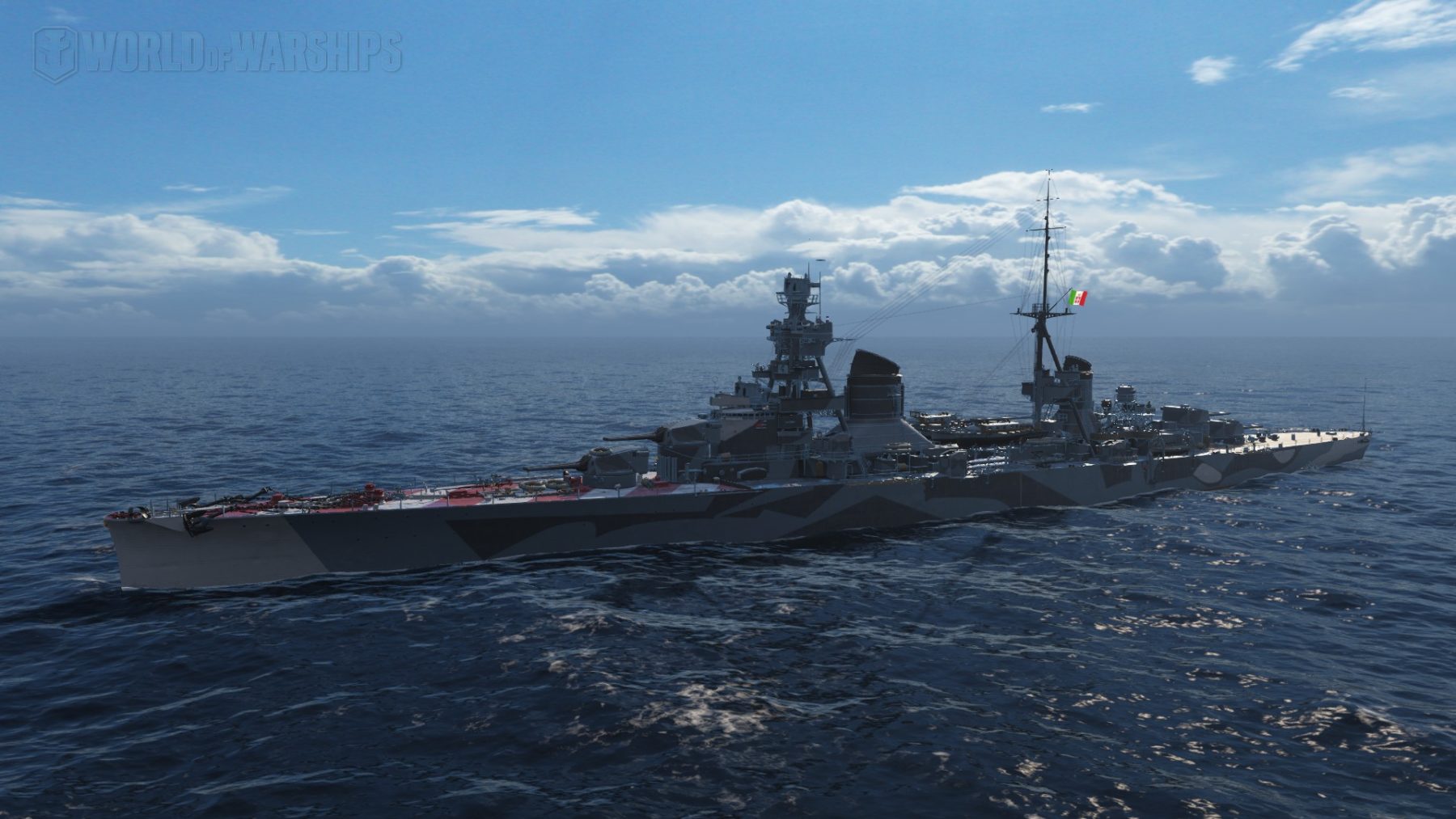
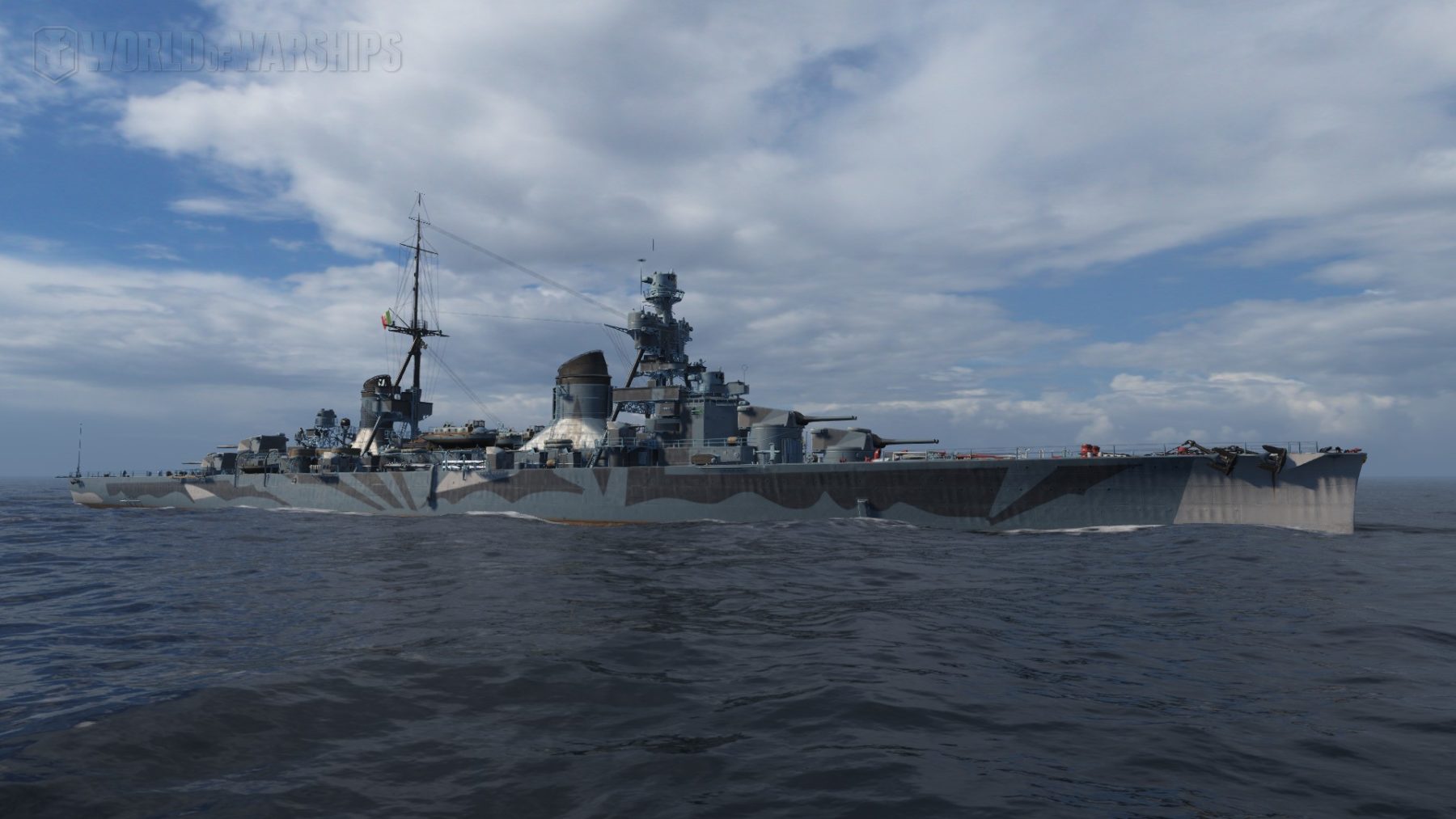
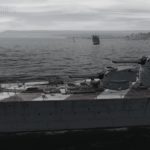
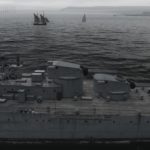
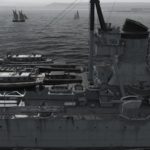
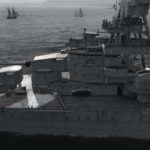
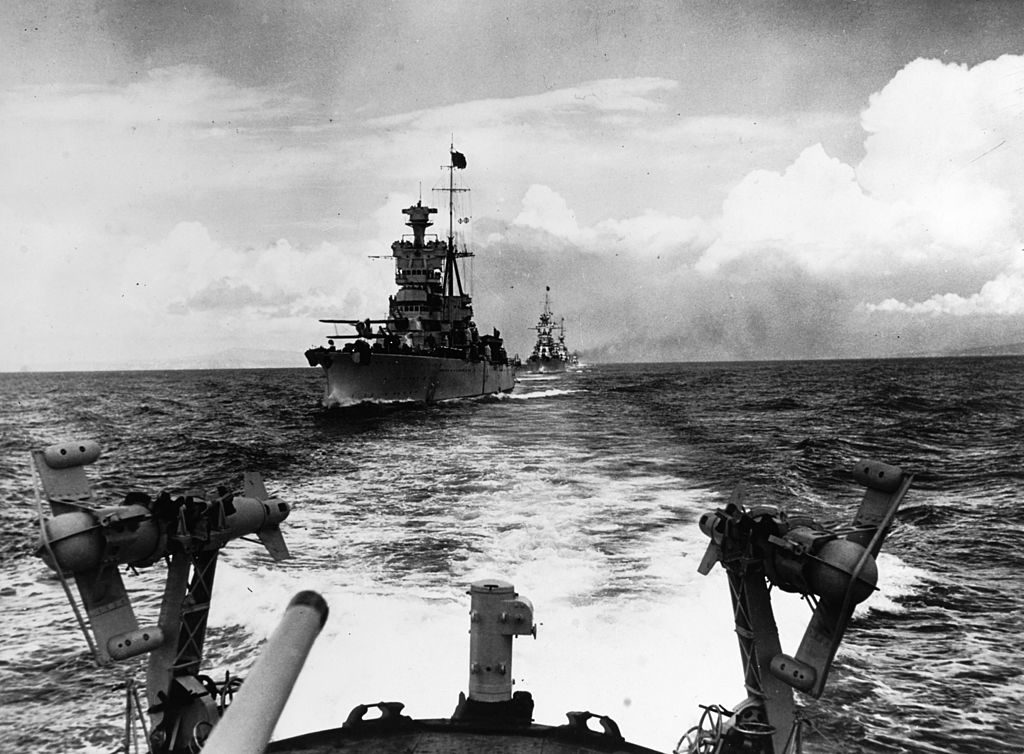
 Latest Facebook Entry -
Latest Facebook Entry -  X(Tweeter) Naval Encyclopedia's deck archive
X(Tweeter) Naval Encyclopedia's deck archive Instagram (@navalencyc)
Instagram (@navalencyc)





 French Navy
French Navy Royal Navy
Royal Navy Russian Navy
Russian Navy Armada Espanola
Armada Espanola Austrian Navy
Austrian Navy K.u.K. Kriegsmarine
K.u.K. Kriegsmarine Dansk Marine
Dansk Marine Nautiko Hellenon
Nautiko Hellenon Koninklije Marine 1870
Koninklije Marine 1870 Marinha do Brasil
Marinha do Brasil Osmanlı Donanması
Osmanlı Donanması Marina Do Peru
Marina Do Peru Marinha do Portugal
Marinha do Portugal Regia Marina 1870
Regia Marina 1870 Nihhon Kaigun 1870
Nihhon Kaigun 1870 Preußische Marine 1870
Preußische Marine 1870 Russkiy Flot 1870
Russkiy Flot 1870 Svenska marinen
Svenska marinen Søværnet
Søværnet Union Navy
Union Navy Confederate Navy
Confederate Navy Armada de Argentina
Armada de Argentina Imperial Chinese Navy
Imperial Chinese Navy Marinha do Portugal
Marinha do Portugal Mexico
Mexico Kaiserliche Marine
Kaiserliche Marine 1898 US Navy
1898 US Navy Sovietskiy Flot
Sovietskiy Flot Royal Canadian Navy
Royal Canadian Navy Royal Australian Navy
Royal Australian Navy RNZN Fleet
RNZN Fleet Chinese Navy 1937
Chinese Navy 1937 Kriegsmarine
Kriegsmarine Chilean Navy
Chilean Navy Danish Navy
Danish Navy Finnish Navy
Finnish Navy Hellenic Navy
Hellenic Navy Polish Navy
Polish Navy Romanian Navy
Romanian Navy Turkish Navy
Turkish Navy Royal Yugoslav Navy
Royal Yugoslav Navy Royal Thai Navy
Royal Thai Navy Minor Navies
Minor Navies Albania
Albania Austria
Austria Belgium
Belgium Columbia
Columbia Costa Rica
Costa Rica Cuba
Cuba Czechoslovakia
Czechoslovakia Dominican Republic
Dominican Republic Haiti
Haiti Hungary
Hungary Honduras
Honduras Estonia
Estonia Iceland
Iceland Eire
Eire Equador
Equador Iran
Iran Iraq
Iraq Latvia
Latvia Liberia
Liberia Lithuania
Lithuania Mandchukuo
Mandchukuo Morocco
Morocco Nicaragua
Nicaragua Persia
Persia San Salvador
San Salvador Sarawak
Sarawak Uruguay
Uruguay Venezuela
Venezuela Zanzibar
Zanzibar Warsaw Pact Navies
Warsaw Pact Navies Bulgaria
Bulgaria Hungary
Hungary

 Bundesmarine
Bundesmarine Dutch Navy
Dutch Navy Hellenic Navy
Hellenic Navy Marina Militare
Marina Militare Yugoslav Navy
Yugoslav Navy Chinese Navy
Chinese Navy Indian Navy
Indian Navy Indonesian Navy
Indonesian Navy JMSDF
JMSDF North Korean Navy
North Korean Navy Pakistani Navy
Pakistani Navy Philippines Navy
Philippines Navy ROKN
ROKN Rep. of Singapore Navy
Rep. of Singapore Navy Taiwanese Navy
Taiwanese Navy IDF Navy
IDF Navy Saudi Navy
Saudi Navy Royal New Zealand Navy
Royal New Zealand Navy Egyptian Navy
Egyptian Navy South African Navy
South African Navy






























 Ukrainian Navy
Ukrainian Navy dbodesign
dbodesign